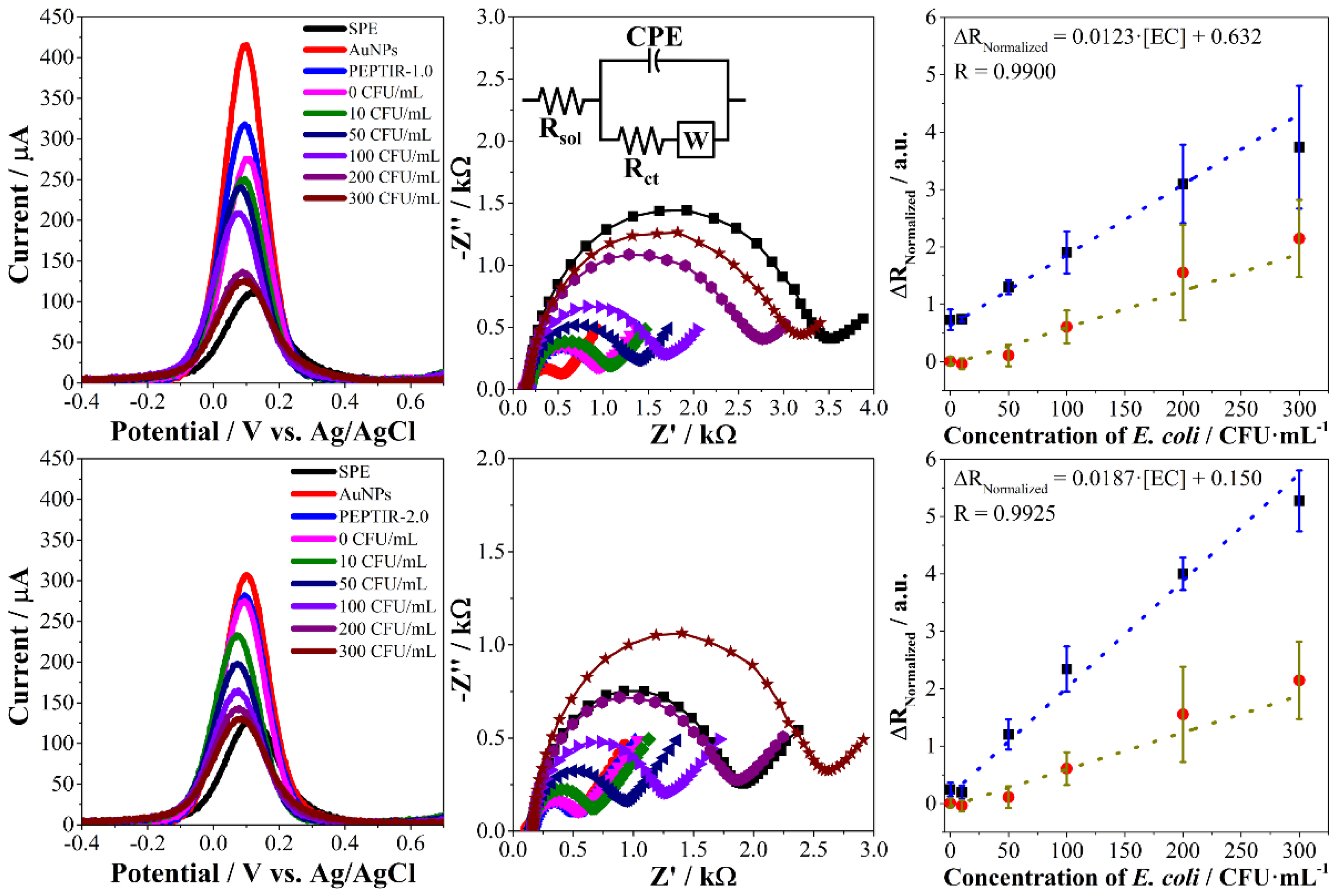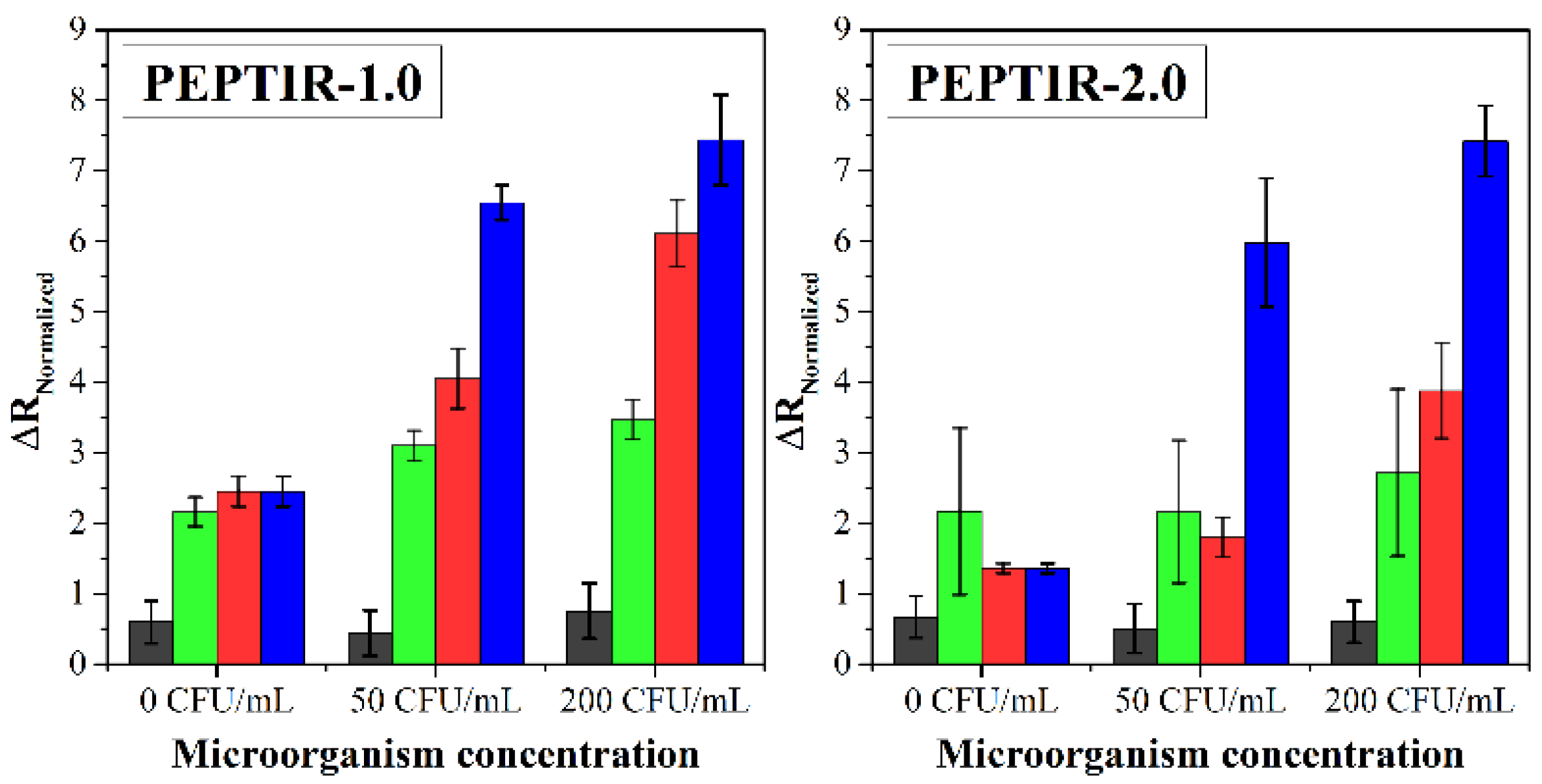New PEPTIR-2.0 Peptide Designed for Use as Recognition Element in Electrochemical Biosensors with Improved Specificity towards E. coli O157:H7
Abstract
:1. Introduction
2. Results and Discussion
2.1. Modeling of Sequences Analogous to the PEPTIR Molecule
2.2. Molecular Docking between the Newly Designed Molecule and the INTIMIN Protein
2.3. Preparation and Evaluation of PEPTIR Based Biosensors
3. Materials and Methods
3.1. Reagents, Materials, and Instruments
3.2. Modeling of Sequences Analogous to the PEPTIR Molecule
3.3. Molecular Docking between the Newly Designed Molecule and the Intimin Protein
3.4. Preparation of the Electrochemical Biosensors
3.5. Electrochemical Characterization of the Biosensors
3.6. Detection of E. coli Cells Using the Electrochemical Biosensors
4. Conclusions
Supplementary Materials
Author Contributions
Funding
Institutional Review Board Statement
Informed Consent Statement
Data Availability Statement
Conflicts of Interest
References
- Puiu, M.; Bala, C. Peptide-based electrochemical biosensors. In Electrochemical Biosensors; Elsevier: Amsterdam, The Netherlands, 2019; pp. 277–306. ISBN 9780128164914. [Google Scholar]
- Daniels, J.S.; Pourmand, N. Label-Free Impedance Biosensors: Opportunities and Challenges. Electroanalysis 2007, 19, 1239–1257. [Google Scholar] [CrossRef] [PubMed]
- Yamanaka, K.; Vestergaard, M.; Tamiya, E. Printable Electrochemical Biosensors: A Focus on Screen-Printed Electrodes and Their Application. Sensors 2016, 16, 1761. [Google Scholar] [CrossRef] [PubMed] [Green Version]
- Florea, A.; Melinte, G.; Simon, I.; Cristea, C. Electrochemical Biosensors as Potential Diagnostic Devices for Autoimmune Diseases. Biosensors 2019, 9, 38. [Google Scholar] [CrossRef] [PubMed] [Green Version]
- Ahmed, A.; Rushworth, J.V.; Hirst, N.A.; Millner, P.A. Biosensors for Whole-Cell Bacterial Detection. Clin. Microbiol. Rev. 2014, 27, 631–646. [Google Scholar] [CrossRef] [PubMed] [Green Version]
- Sandhyarani, N. Surface modification methods for electrochemical biosensors. In Electrochemical Biosensors; Elsevier: Amsterdam, The Netherlands, 2019; pp. 45–75. ISBN 9780128164914. [Google Scholar]
- Honeychurch, K.C.; Boujtita, M.; Davis, F.; Higson, S.P.J.; Metters, J.P.; Banks, C.E.; Rawson, F.J.; Francioso, L.; Yarman, A.; Turner, A.P.F.; et al. Nanosensors for Chemical and Biological Applications; Woodhead Publishing: Cambridge, UK, 2014; ISBN 978-0-85709-660-9. [Google Scholar]
- Thévenot, D.R.; Toth, K.; Durst, R.A.; Wilson, G.S. Electrochemical biosensors: Recommended definitions and classification. Biosens. Bioelectron. 2001, 16, 121–131. [Google Scholar] [CrossRef]
- Pumera, M.; Sánchez, S.; Ichinose, I.; Tang, J. Electrochemical nanobiosensors. Sensors Actuators B Chem. 2007, 123, 1195–1205. [Google Scholar] [CrossRef]
- Song, S.; Wang, L.; Li, J.; Fan, C.; Zhao, J. Aptamer-based biosensors. TrAC Trends Anal. Chem. 2008, 27, 108–117. [Google Scholar] [CrossRef]
- Taleat, Z.; Khoshroo, A.; Mazloum-Ardakani, M. Screen-printed electrodes for biosensing: A review (2008–2013). Microchim. Acta 2014, 181, 865–891. [Google Scholar] [CrossRef]
- Razmi, N.; Hasanzadeh, M.; Willander, M.; Nur, O. Recent Progress on the Electrochemical Biosensing of Escherichia coli O157:H7: Material and Methods Overview. Biosensors 2020, 10, 54. [Google Scholar] [CrossRef] [PubMed]
- Karimzadeh, A.; Hasanzadeh, M.; Shadjou, N.; Guardia, M. de la Peptide based biosensors. TrAC Trends Anal. Chem. 2018, 107, 1–20. [Google Scholar] [CrossRef]
- Malvano, F.; Pilloton, R.; Albanese, D. A novel impedimetric biosensor based on the antimicrobial activity of the peptide nisin for the detection of Salmonella spp. Food Chem. 2020, 325, 126868. [Google Scholar] [CrossRef] [PubMed]
- Puiu, M.; Bala, C. Peptide-based biosensors: From self-assembled interfaces to molecular probes in electrochemical assays. Bioelectrochemistry 2018, 120, 66–75. [Google Scholar] [CrossRef] [PubMed]
- Zhang, J.; Cao, Y. Peptide-Based Biosensors. In Nano-Inspired Biosensors for Protein Assay with Clinical Applications; Elsevier: Amsterdam, The Netherlands, 2019; pp. 167–185. ISBN 9780128150535. [Google Scholar]
- Ropero-Vega, J.L.; Redondo-Ortega, J.F.; Galvis-Curubo, Y.J.; Rondón-Villarreal, P.; Flórez-Castillo, J.M. A bioinspired peptide in tir protein as recognition molecule on electrochemical biosensors for the detection of e. Coli o157:H7 in an aqueous matrix. Molecules 2021, 26, 2559. [Google Scholar] [CrossRef] [PubMed]
- Kanyong, P.; Rawlinson, S.; Davis, J. Gold nanoparticle modified screen-printed carbon arrays for the simultaneous electrochemical analysis of lead and copper in tap water. Microchim. Acta 2016, 183, 2361–2368. [Google Scholar] [CrossRef]
- López-Lorente, Á.I.; Valcárcel, M. Gold Nanoparticles in Analytical Chemistry; Elsevier: Amsterdam, The Netherlands, 2014; Volume 66, ISBN 9780444632852. [Google Scholar]
- López-Lorente, Á.I.; Valcárcel, M. Analytical Nanoscience and Nanotechnology. Compr. Anal. Chem. 2014, 66, 3–35. [Google Scholar]
- Barreiros dos Santos, M.; Agusil, J.P.; Prieto-Simón, B.; Sporer, C.; Teixeira, V.; Samitier, J. Highly sensitive detection of pathogen Escherichia coli O157:H7 by electrochemical impedance spectroscopy. Biosens. Bioelectron. 2013, 45, 174–180. [Google Scholar] [CrossRef] [PubMed]
- Hoyos-Nogués, M.; Gil, F.J.; Mas-Moruno, C. Antimicrobial Peptides: Powerful Biorecognition Elements to Detect Bacteria in Biosensing Technologies. Molecules 2018, 23, 1683. [Google Scholar] [CrossRef] [PubMed] [Green Version]
- Cesewski, E.; Johnson, B.N. Electrochemical biosensors for pathogen detection. Biosens. Bioelectron. 2020, 159, 112214. [Google Scholar] [CrossRef] [PubMed]
- Maupetit, J.; Derreumaux, P.; Tuffery, P. PEP-FOLD: An online resource for de novo peptide structure prediction. Nucleic Acids Res. 2009, 37, W498–W503. [Google Scholar] [CrossRef] [PubMed] [Green Version]
- Schrodinger, L. The PyMOL Molecular Graphics System, Version Open-Source PyMOL 1.8.x. Available online: https:%0A//github.com/schrodinger/pymol-open-source (accessed on 1 July 2021).
- Raveh, B.; London, N.; Schueler-Furman, O. Sub-angstrom modeling of complexes between flexible peptides and globular proteins. Proteins Struct. Funct. Bioinforma. 2010, 78, 2029–2040. [Google Scholar] [CrossRef] [PubMed]





| Analogous Peptides | Sequence | RMSD |
|---|---|---|
| PEPTIR-1.0 | QKVNIDELGNAIPSGVLKDD | 4.25 |
| 1 | QKVNILLLGNAIPSGVLLDD | 5.48 |
| 2 | QKVNIAELGNAIPSGVLKDD | 3.50 |
| 3 | QKVNIMMLGNAIPSGVLMDD | 4.86 |
| Model | ΔG (kcal/mol) | Kd (mol/L) | I_SC | Interactions |
|---|---|---|---|---|
| TIR protein | −11.50 | 3.7 × 10−9 | - | 62 |
| PEPTIR-1.0 | −10.9 | 9.6 × 10−9 | −18.106 | 52 |
| 1 | −10.7 | 1.4 × 10−8 | −18.790 | 51 |
| 2 | −13.1 | 2.6 × 10−10 | −24.329 | 63 |
| 3 | −11.8 | 2.0 × 10−9 | −10.900 | 41 |
| Biosensor | Limit of Detection (CFU/mL) | Limit of Quantification (CFU/mL) | Calibration Sensitivity (1/CFU·mL−1) |
|---|---|---|---|
| PEPTIR-1.0 | 44 | 146 | 0.0123 |
| PEPTIR-2.0 | 19 | 65 | 0.0187 |
Publisher’s Note: MDPI stays neutral with regard to jurisdictional claims in published maps and institutional affiliations. |
© 2022 by the authors. Licensee MDPI, Basel, Switzerland. This article is an open access article distributed under the terms and conditions of the Creative Commons Attribution (CC BY) license (https://creativecommons.org/licenses/by/4.0/).
Share and Cite
Ropero-Vega, J.L.; Redondo-Ortega, J.F.; Rodríguez-Caicedo, J.P.; Rondón-Villarreal, P.; Flórez-Castillo, J.M. New PEPTIR-2.0 Peptide Designed for Use as Recognition Element in Electrochemical Biosensors with Improved Specificity towards E. coli O157:H7. Molecules 2022, 27, 2704. https://doi.org/10.3390/molecules27092704
Ropero-Vega JL, Redondo-Ortega JF, Rodríguez-Caicedo JP, Rondón-Villarreal P, Flórez-Castillo JM. New PEPTIR-2.0 Peptide Designed for Use as Recognition Element in Electrochemical Biosensors with Improved Specificity towards E. coli O157:H7. Molecules. 2022; 27(9):2704. https://doi.org/10.3390/molecules27092704
Chicago/Turabian StyleRopero-Vega, Jose Luis, Joshua Felipe Redondo-Ortega, Juliana Paola Rodríguez-Caicedo, Paola Rondón-Villarreal, and Johanna Marcela Flórez-Castillo. 2022. "New PEPTIR-2.0 Peptide Designed for Use as Recognition Element in Electrochemical Biosensors with Improved Specificity towards E. coli O157:H7" Molecules 27, no. 9: 2704. https://doi.org/10.3390/molecules27092704
APA StyleRopero-Vega, J. L., Redondo-Ortega, J. F., Rodríguez-Caicedo, J. P., Rondón-Villarreal, P., & Flórez-Castillo, J. M. (2022). New PEPTIR-2.0 Peptide Designed for Use as Recognition Element in Electrochemical Biosensors with Improved Specificity towards E. coli O157:H7. Molecules, 27(9), 2704. https://doi.org/10.3390/molecules27092704






